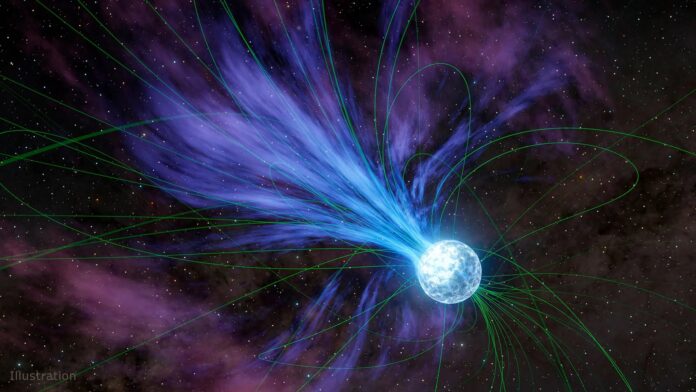Using two NASA X-ray telescopes, researchers observed a mysterious burst of radio waves from a dead star known as a fast radio burst (FRB). These bursts are brief but incredibly powerful, releasing as much energy in a fraction of a second as the Sun does in a year. They also emit light in a focused beam, unlike other cosmic explosions.
Before 2020, FRBs were thought to originate from outside our galaxy, making it challenging to determine their source. However, in 2020, an FRB was detected within our galaxy, arising from a dense object called a magnetar, which is the collapsed core of an exploded star.
In October 2022, the same magnetar, SGR 1935+2154, produced another FRB. NASA‘s NICER and NuSTAR telescopes observed this event, capturing images of the magnetar before and after the burst. They found that the magnetar experienced a sudden increase in spin speed, known as a glitch, followed by the FRB. Surprisingly, the magnetar rapidly slowed to its previous speed within nine hours, much faster than ever observed before.
Before the fast radio burst in 2022, the magnetar released bursts of X-rays and gamma rays, which are even more energetic than X-rays. Although these bursts had enough energy to create a fast radio burst potentially, they didn’t. However, something changed during the slowdown period after the burst, creating the right conditions.
One possibility is that the magnetar’s exterior is solid, while the interior is in a state called a superfluid. Sometimes, these two parts can become out of sync, like water sloshing inside a spinning fishbowl. This can result in the fluid delivering energy to the crust, possibly causing both glitches that bookended the fast radio burst.
The initial glitch might have caused a crack in the magnetar‘s surface, releasing material into space like a volcanic eruption. This mass loss can cause spinning objects to slow down, explaining the magnetar’s rapid deceleration.
However, since this event is the only one observed in real-time, it’s still uncertain which factors, such as the magnetar’s magnetic field, might contribute to a fast radio burst. The team believes they have witnessed something significant for understanding fast radio bursts.
Journal Reference:
- Hu, CP., Narita, T., Enoto, T. et al. Rapid spin changes around a magnetar fast radio burst. Nature 626, 500–504 (2024). DOI: 10.1038/s41586-023-07012-5
